Key Technologies for Surface-Borehole Transient Electromagnetic Systems and Applications
Abstract
:1. Introduction
2. Characteristics of Surface-Borehole Transient Electromagnetic Responses
3. Borehole Electromagnetic Signal Acquisition System
3.1. Non-Polarized Electrodes and Three-Component Magnetic Sensor
3.2. Key Technologies of the Borehole Electromagnetic Signal Acquisition System
3.2.1. Channel Gain
3.2.2. Sampling Frequency
3.2.3. Synchronization of the Surface Transmission System and the Borehole Electromagnetic Signal Acquisition System
4. Tests in Real Mines
4.1. Transient Electromagnetic Test with a Long Wire Source
4.2. Transient Electromagnetic Test with a Large Loop Source
5. Conclusions
- The borehole electromagnetic signal acquisition system designed in this study achieved the synchronous acquisition and storage of time-domain signals of three-component magnetic field signals and electrical signals in the borehole;
- The logging results had strong regularity and were correlated to the position of the mineralized metallic ore. The attenuation time curves had low amplitudes in the mineralized metallic ore layer, and the time-domain curves also converged well;
- The borehole electromagnetic signal acquisition system rotated during the logging process, resulting in scattered magnetic signals. To solve this problem, a push-back device and azimuth-measuring section were installed to prevent the electromagnetic acquisition system from rotating during the measurement, and the real-time instrument rotation angle and status were measured for angle compensation. In addition, the stability and sensitivity of the three-component magnetic field sensor will be improved in future research.
- Due to difficulties in finding a deep metal mine, the temperature and pressure of the metal mine selected in this study were far below the maximum performance of the system at 3000 m. However, the response characteristics indicated the efficacy of the borehole receiver; hence, it could be commercialized.
Author Contributions
Funding
Data Availability Statement
Conflicts of Interest
References
- Becker, A.R.; DeCarle, R.; Lazenby, P.G. Simplified prediction of transient electromagnetic response. Geophysics 1984, 49, 913–917. [Google Scholar] [CrossRef]
- Nguyen Dinh, C.; Klityński, W.; Pham Nguyen, P.; Oryński, S. Application of electromagnetic transient method for Zn–Pb exploration at the Cho Dien–Cho Don District, Bac Can Province, North Vietnam. Acta Geophys. 2019, 67, 1921–1931. [Google Scholar] [CrossRef]
- Azizuddin, A.A.; Kurt, S.; Tilman, H. Surface-to-borehole TEM for reservoir monitoring. In Proceedings of the 2011 SEG Annual Meeting, San Antonio, TX, USA, 18–23 September 2011; pp. 1882–1886. [Google Scholar]
- Barajas-Olalde, C.; Adams, D.C.; Curcio, A.; Davydycheva, S.; Klapperich, R.J.; Martinez, Y.; Paembonan, A.Y.; Peck, W.D.; Strack, K.; Soupios, P. Application of Electromagnetic Methods for Reservoir Monitoring with Emphasis on Carbon Capture, Utilization, and Storage. Minerals 2023, 13, 1308. [Google Scholar] [CrossRef]
- Li, H.; Mao, Y.; Wang, X.; Yan, L.; Zhou, L. Characterization of Surface–Borehole Transient Electromagnetic Response in Electrical Anisotropic Media. Minerals 2023, 13, 674. [Google Scholar] [CrossRef]
- Wu, J.; Zhi, Q.; Deng, X.; Wang, X.; Chen, X.; Zhao, Y.; Huang, Y. Deep Gold Exploration with SQUID TEM in the Qingchengzi Orefield, Eastern Liaoning, Northeast China. Minerals 2022, 12, 102. [Google Scholar] [CrossRef]
- Bailey, J.; Lafrance, B.; McDonald, M.A.; Fedorowich, J. Mazatzal Labradorian-age ductile deformation of the South Range Sudbury impact structure at the Thayer Lindsley mine, Ontario. Can. J. Earth Sci. 2004, 41, 1491–1505. [Google Scholar] [CrossRef]
- Molnar, F.; Watkinson, D.H.; Jones, P.C. Fluid inclusion evidence for hydrothermal enrichment of magmatic ore at the contact zone of the Ni-Cu-platinum-group element 4b Deposit, Lindsley Mine, Sudbury. Can. Econ. Geol. 1997, 92, 674–685. [Google Scholar] [CrossRef]
- Sun, H.R.; Zhang, Y.Y.; Zhao, Y.C.; Liu, Y.; Zhao, H. Present study situation review of borehole transient electromagnetic method. Coal Geol. Explor. 2022, 50, 85–97. [Google Scholar]
- Nepeina, K.; Bataleva, E.; Alexandrov, P. Electromagnetic Monitoring of Modern Geodynamic Processes: An Approach for Micro-Inhomogeneous Rock through Effective Parameters. Appl. Sci 2023, 13, 8063. [Google Scholar] [CrossRef]
- Lévesque, Y.; Walter, J.; Chesnaux, R. Transient Electromagnetic (TEM) Surveys as a First Approach for Characterizing a Regional Aquifer: The Case of the Saint-Narcisse Moraine, Quebec, Canada. Geosciences 2021, 11, 415. [Google Scholar] [CrossRef]
- Kalisperi, D.; Kouli, M.; Vallianatos, F.; Soupios, P.; Kershaw, S.; Lydakis-Simantiris, N. A Transient ElectroMagnetic (TEM) Method Survey in North-Central Coast of Crete, Greece: Evidence of Seawater Intrusion. Geosciences 2018, 8, 107. [Google Scholar] [CrossRef]
- Ravenhurst, B.; Roth, J. Memorials. Lead. Edge 2011, 30, 594. [Google Scholar]
- Daniels, J.J.; Dyck, A. Borehole Resistivity and Electromagnetic Methods Applied to Mineral Exploration. IEEE Trans. Geosci. Remote Sens. 1984, 22, 80–87. [Google Scholar] [CrossRef]
- Dyck, A.V. Drill-Hole Electromagnetic Methods. In Electromagnetic Methods in Applied Geophysics: Volume 2, Application, Parts A and B; Society of Exploration Geophysicists: Houston, TX, USA, 1991. [Google Scholar]
- Zhang, Y.X.; Han, Z.H.; Zhou, J.X.; Kang, H.W.; Zhou, T. The application effect of mining hydrogeological exploration using PROTEM67D system. Chin. J. Eng. Geophys. 2005, 2, 123–128. [Google Scholar]
- Jiang, B.Y.; Feng, M.L.; Ye, Z.X.; Lu, Q.X.; Chen, D.X. Comprehensive Technologies for Geophysical and Geochemical Exploration for Deep Concealed Mineral Deposits; Institute of Geophysical and Geochemical Exploration, Chinese Academy of Geological Sciences: Langfang, China, 1990. [Google Scholar]
- Ping, H.; Shi, Z.Y. Research Report on Ground-Borehole Transient Electromagnetic Methods and Interpretation Technologies; Institute of Geophysical and Geochemical Exploration, Chinese Academy of Geological Sciences: Langfang, China, 1995. [Google Scholar]
- Ping, H. Technical Manual of Ground-Borehole Transient Electromagnetic Method; Institute of Geophysical and Geochemical Exploration, Chinese Academy of Geological Sciences: Langfang, China, 1995. [Google Scholar]
- Deng, X.H.; Zhang, J.; Wu, J.J.; Wang, X.C.; Yang, Y. Technical Specifications for Surface-Borehole Transient Electromagnetic Method, 1st ed.; China Geological Survey Technical Standards for Geological Survey; China Geological Survey: Hebei, China, 2019.
- Xue, G.Q.; Li, X.D.; Qing, Y. The progress of TEM in theory and application. Prog. Geophys. 2007, 22, 1195–1200. [Google Scholar]
- Yan, S.; Shi, X.X.; Chen, M.S. The probing depth of transient electromagnetic field method. Chin. J. Geophys. 2009, 52, 1583–1591. [Google Scholar]
- Xiu, L. Theory and Application of Transient Electromagnetic Sounding, 1st ed.; Shaanxi Science and Technology Press: Xi’an, China, 2002. [Google Scholar]
- Chen, W.Y.; Han, S.X.; Xue, G.Q. Analysis on the full-component response and detectability of electric source surface-to-borehole TEM method. Chin. J. Geophys. 2019, 62, 1969–1980. [Google Scholar]
- Zhang, X.N.; Yan, L.J.; Huang, X.; Zhou, L.; Wang, X.; Cao, X. Three-Dimensional Forward Modeling of Transient Electromagnetic Method Considering Induced Polarization Effect Based on Spectral Element Method. Minerals 2024, 14, 24. [Google Scholar] [CrossRef]
- Cheng, M.; Yang, D.K.; Luo, Q. Interpreting Surface Large-Loop Time-Domain Electromagnetic Data for Deep Mineral Exploration Using 3D Forward Modeling and Inversion. Minerals 2023, 13, 34. [Google Scholar] [CrossRef]
- Meng, Q.X.; Pan, H.P. Numerical simulation analysis of surface-hole TEM responses. Chin. J. Geophys. 2012, 55, 1046–1053. [Google Scholar]
- Wu, J.J.; Li, X.; Zhi, Q.Q.; Deng, X.; Guo, J. Full field apparent resistivity definition of Borehole TEM with electric source. Chin. J. Geophys. 2017, 60, 1595–1605. [Google Scholar]
- Wang, X.C.; Zhi, Q.Q.; Wu, J.J.; Deng, X.; Huang, Y.; Yang, Q.A.; Wang, J. Multicomponent Transient Electromagnetic Exploration Technology and Its Application. Minerals 2022, 13, 681. [Google Scholar] [CrossRef]
- Wu, J.J.; Li, X.; Zhi, Q.Q.; Qi, Z.P.; Guo, J.L.; Deng, X.H. Analysis of three component TEM response characteristic of electric source dill hole TEM. Prog. Geophys. 2017, 32, 1273–1278. [Google Scholar]
- Yan, C.; Chen, R.J.; Shen, R.J.; Wu, X.; Wan, X.; Chen, X.; Liu, H. Distributed multi-channel data acquisition system for electrical and electromagnetic methods. Prog. Geophys. 2021, 36, 1743–1750. [Google Scholar]
- Huang, J.Y. Development of High-Precision Low-Power Distributed Seismic Acquistion Staion. Master’s Thesis, China University of Geosciences (Beijing), Beijing, China, 2014. [Google Scholar]
- Mao, Y.; Yan, L.; Zhou, L.; Xu, J.; Chen, H. A Set of In-Well Receiver Array for Borehole Induced Polarization Detecting Technology in Deep Mine Exploration. Minerals 2022, 12, 1247. [Google Scholar] [CrossRef]
- Lin, J.; Wang, L.; Wang, X.G.; Cai, M.; Fu, L.; Shang, X.L. Research and development on the air-core coil sensor for mines transient electromagnetic exploration. Chin. J. Geophys. 2016, 59, 721–730. [Google Scholar]
- Liang, Q.H. Transient Electromagnetic Exploration in the Whole Mine Space Using Small Coils and Its Application. Master’s Thesis, Central South University, Changsha, China, 2012. [Google Scholar]
- Dang, B.; Yang, L.; Liu, C.; Zheng, Y.; Li, H.; Dang, R.; Sun, B. A Uniform Linear Multi-Coil Array-Based Borehole Transient Electromagnetic System for Non-Destructive Evaluations of Downhole Casings. Sensors 2018, 18, 2707. [Google Scholar] [CrossRef] [PubMed]
- He, Z.R. Noise Analysis and Design of Operational Amplifier Circuits. Microelectronics 2006, 36, 148–153. [Google Scholar]
- Wu, X.; Xue, G.Q.; Chen, W.Y.; Wu, K.; Qi, L.; Liu, F.B.; Fang, G.Y. Contrast test of the transient electromagnetic system (CASTEM)at the Dawangzhuang iron mine in Anhui province. Chin. J. Geophys. 2016, 59, 4448–4456. [Google Scholar]
- Chen, W.; Han, S.; Khan, Y.M.; Chen, W.; He, Y.; Zhang, L.; Hou, D.; Xue, G. A Surface-to-Borehole TEM System Based on Grounded-wire Sources: Synthetic Modeling and Data Inversion. Pure Appl. Geophys. 2020, 177, 4207–4216. [Google Scholar] [CrossRef]

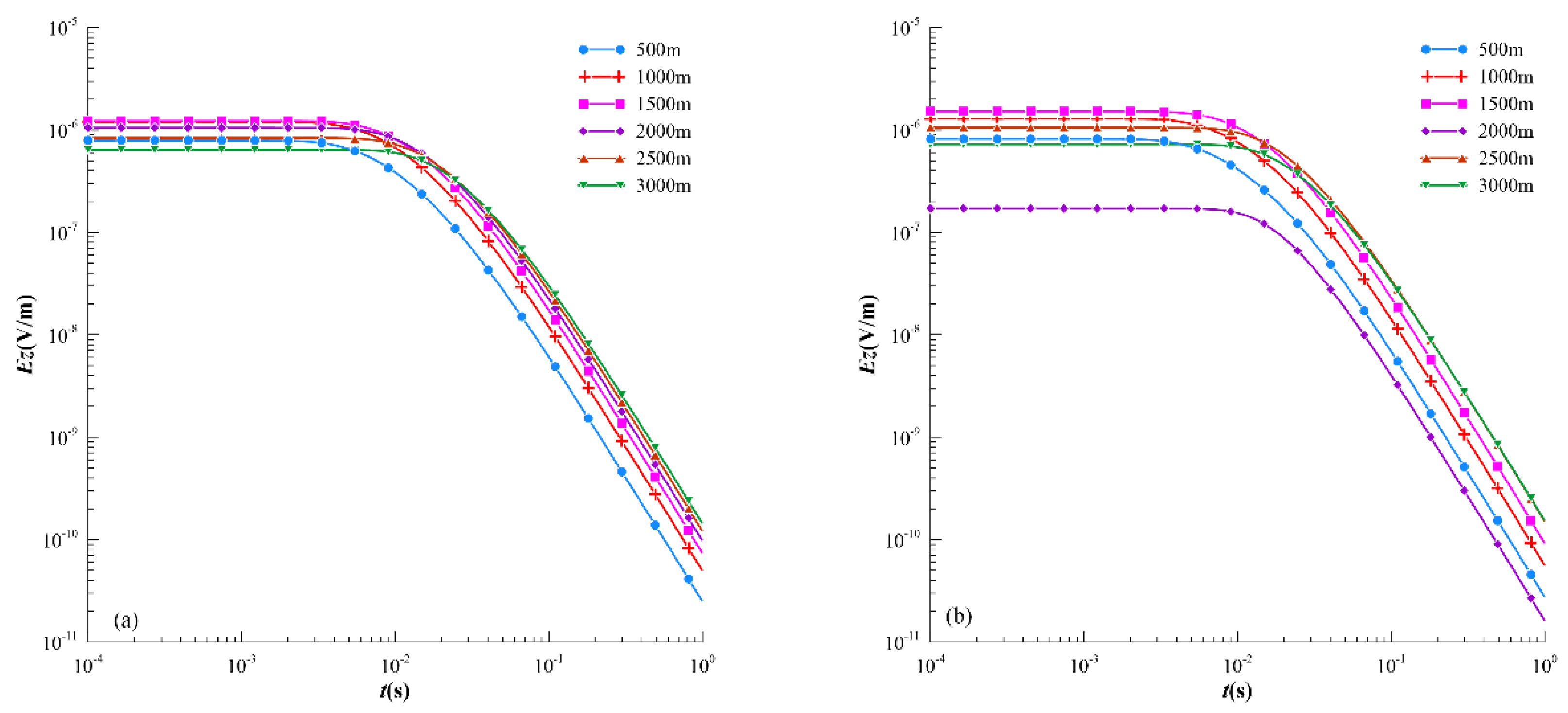

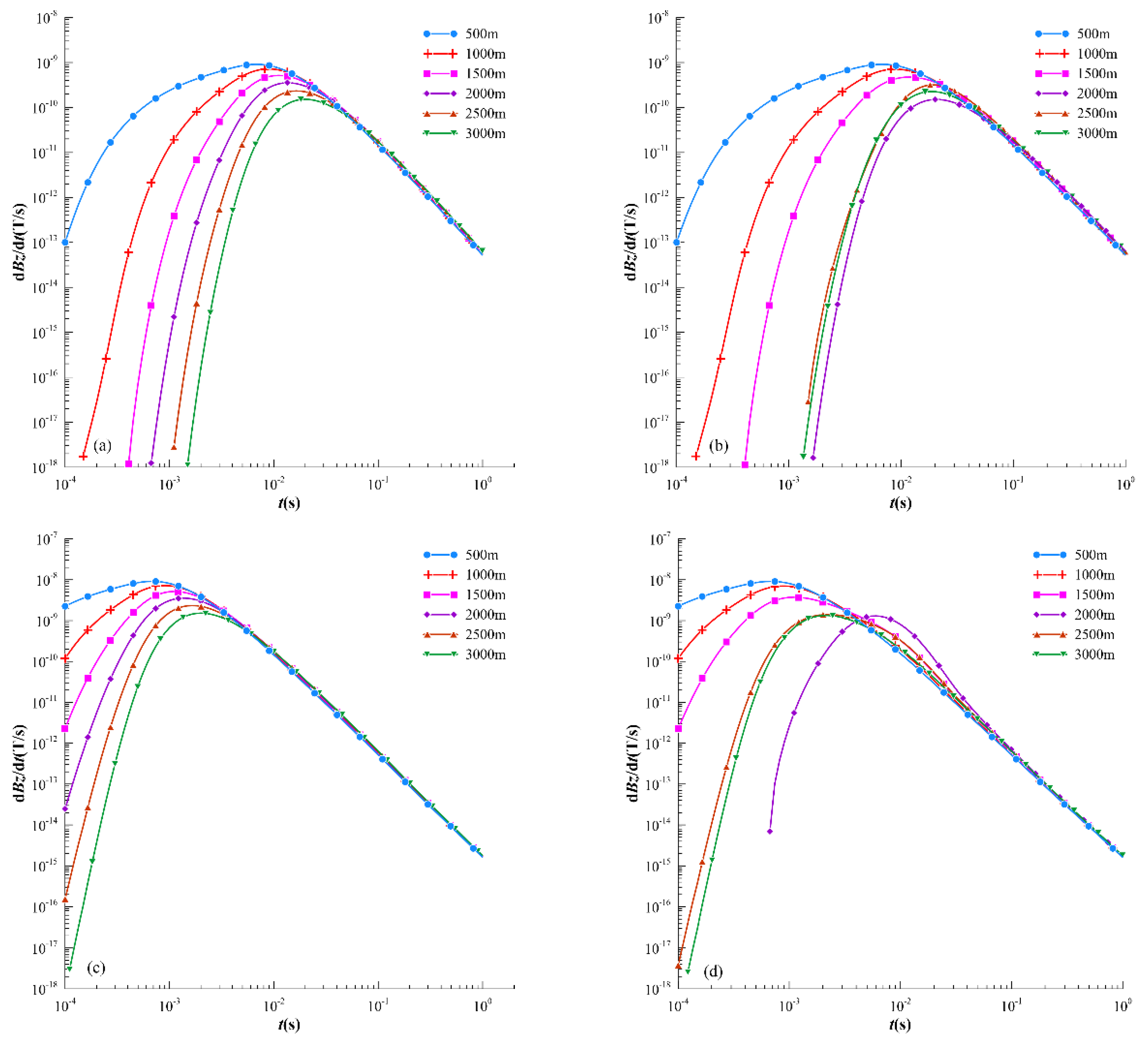
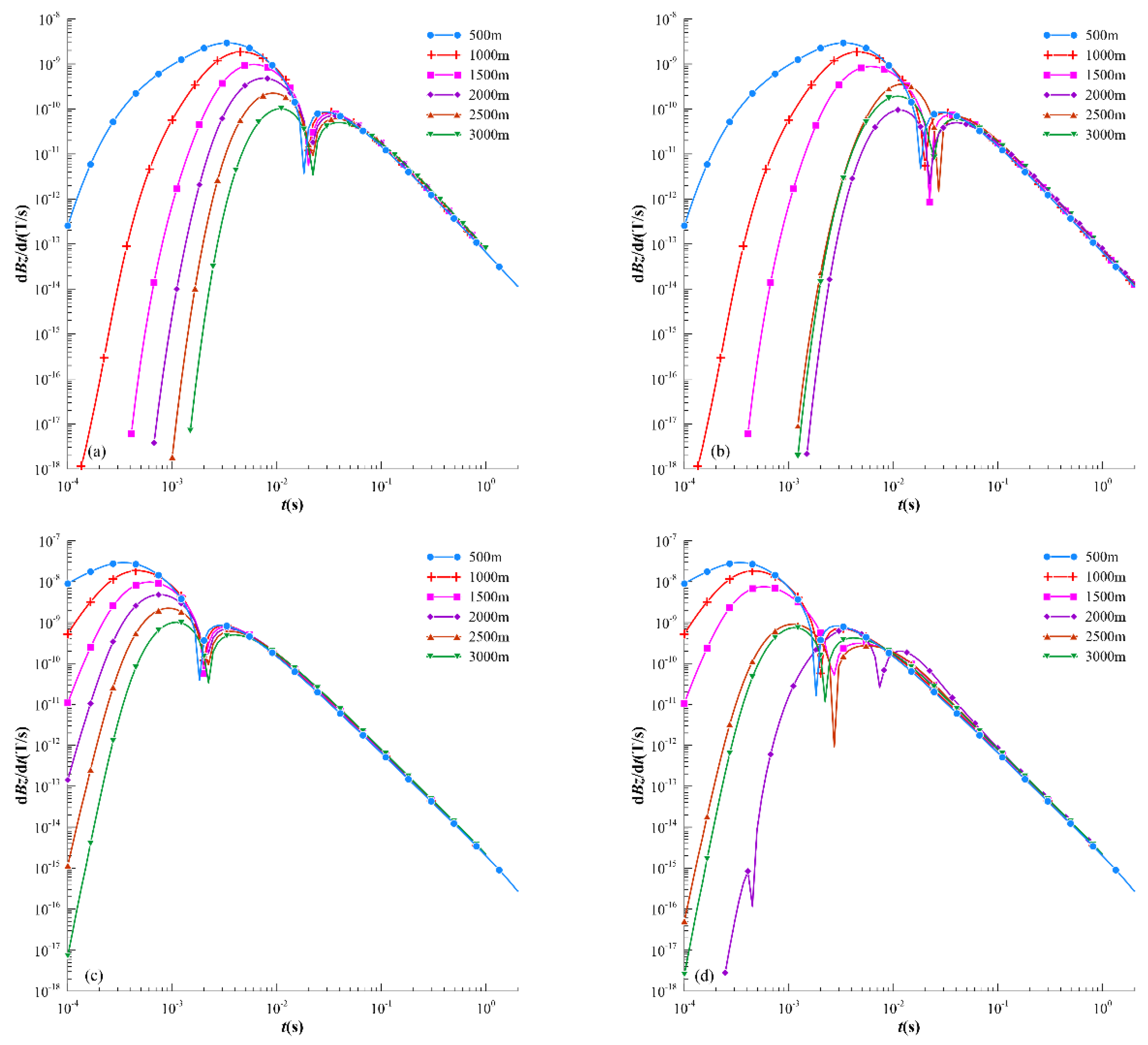
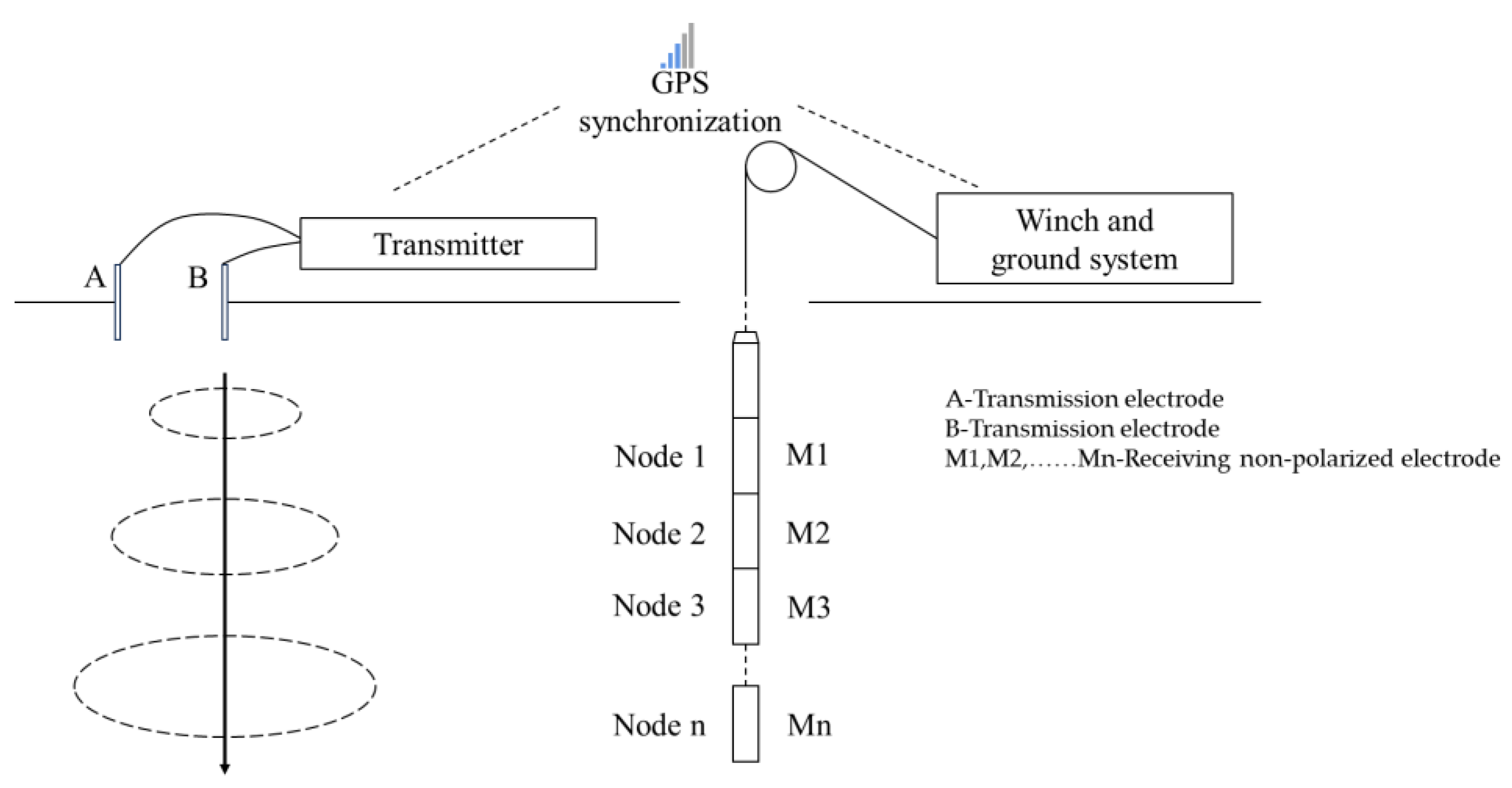

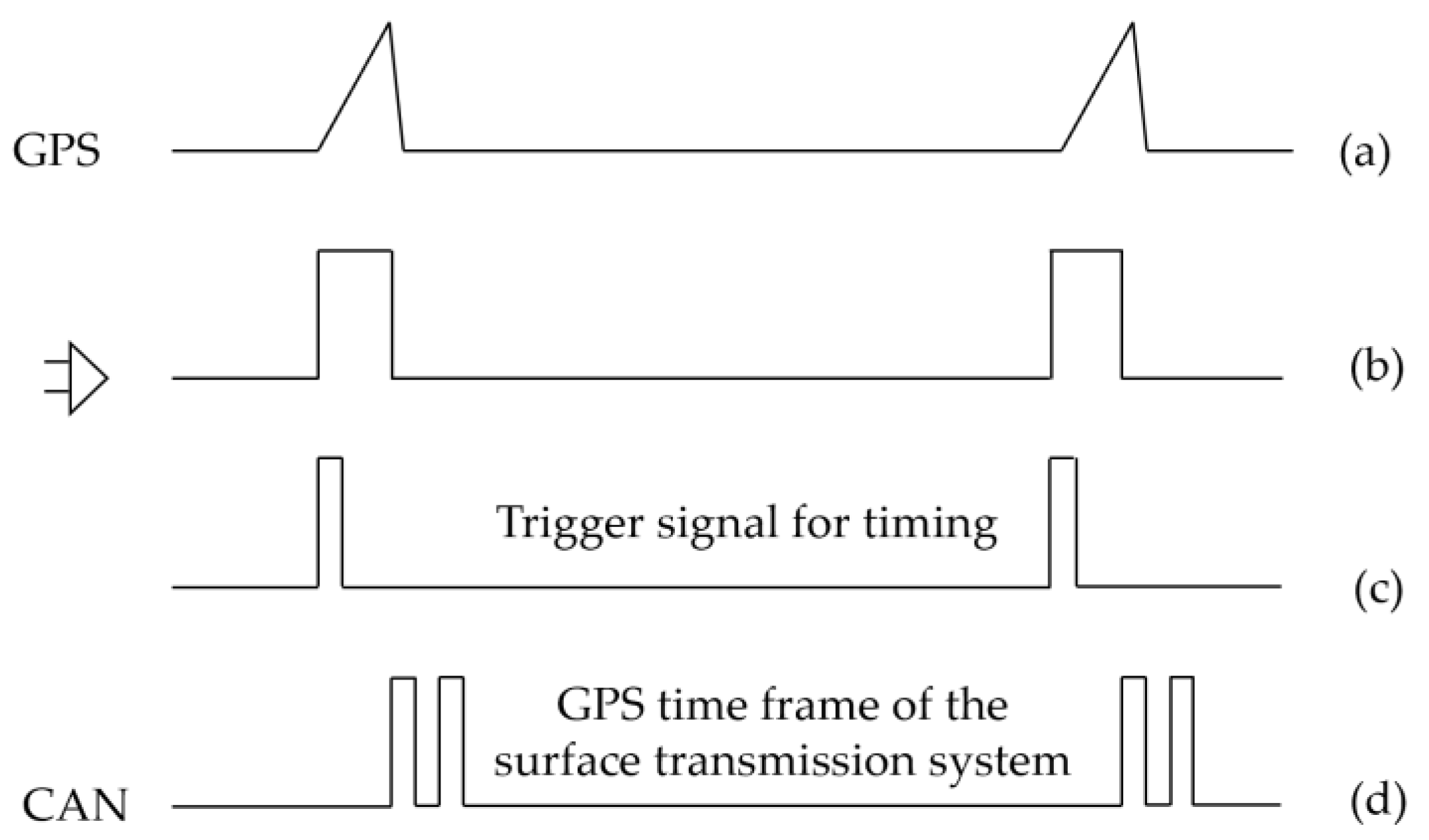

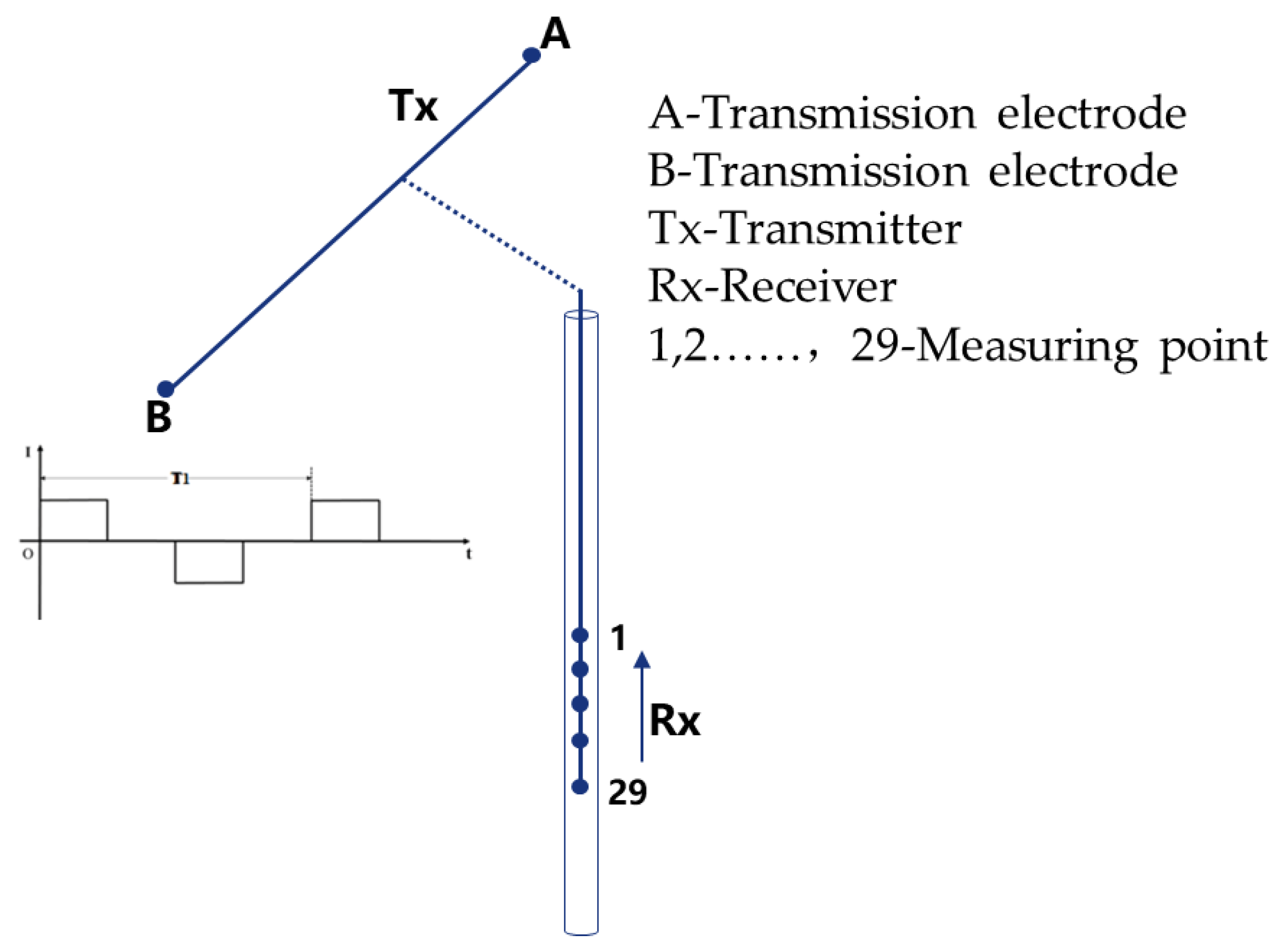
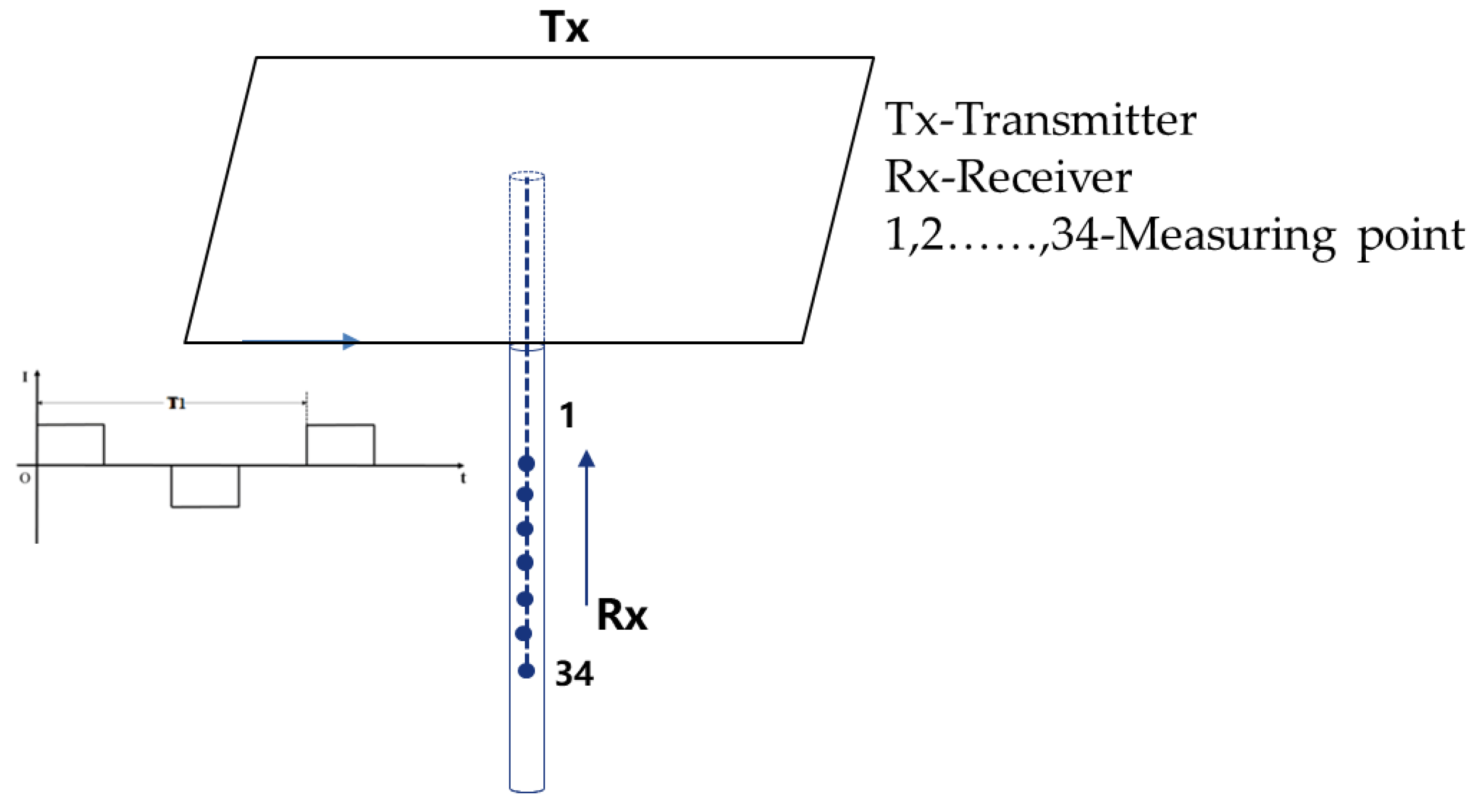



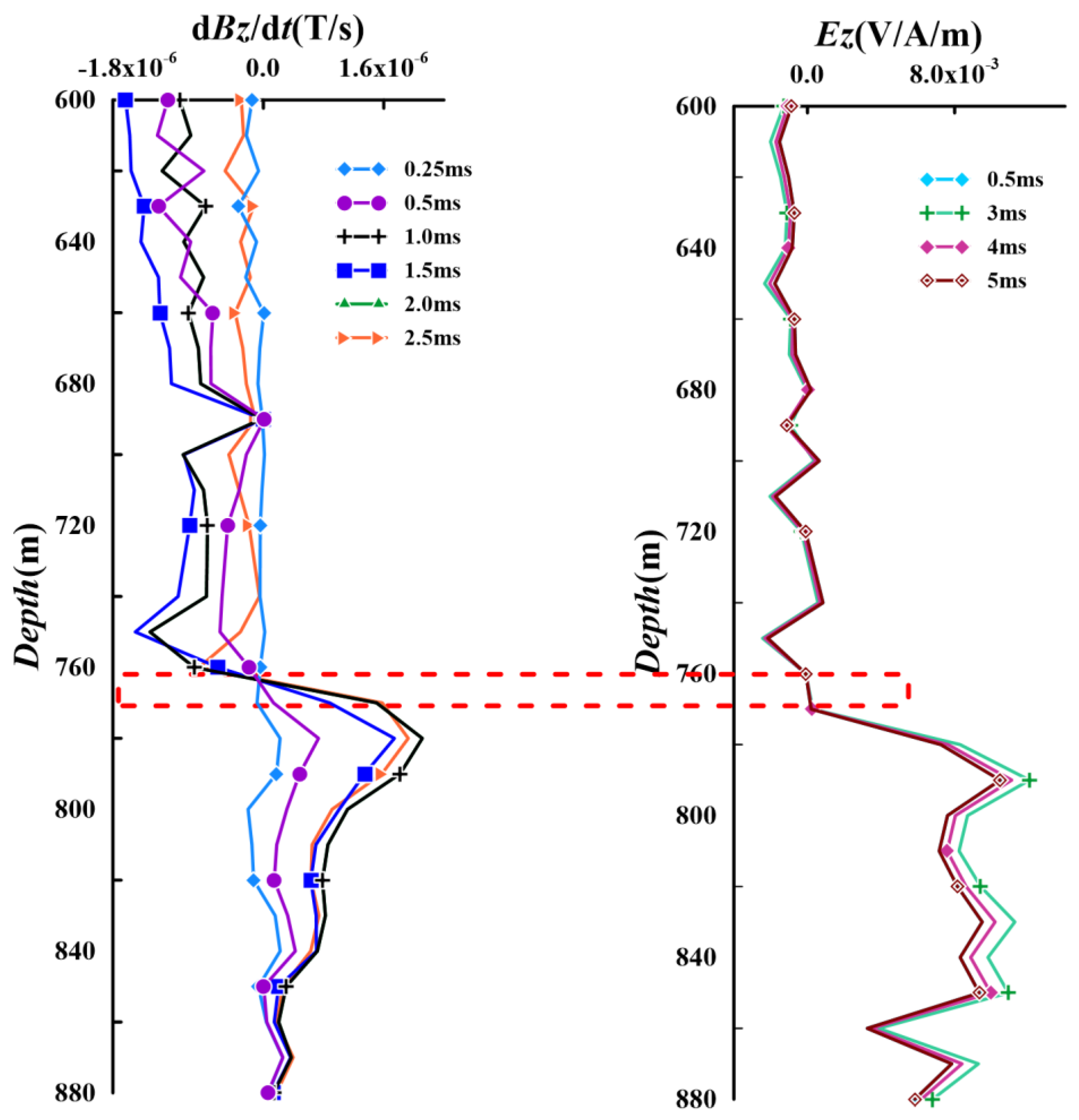
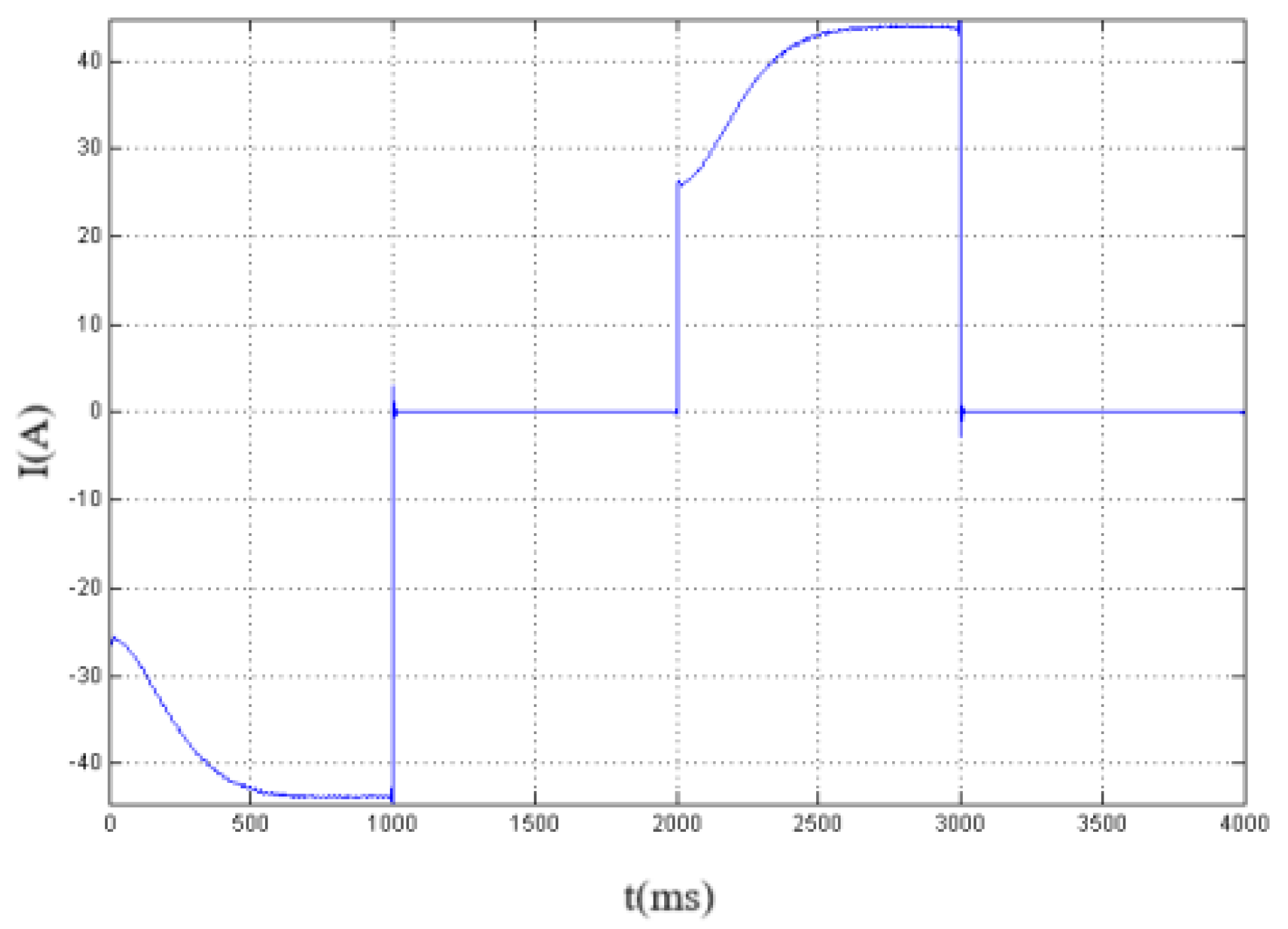

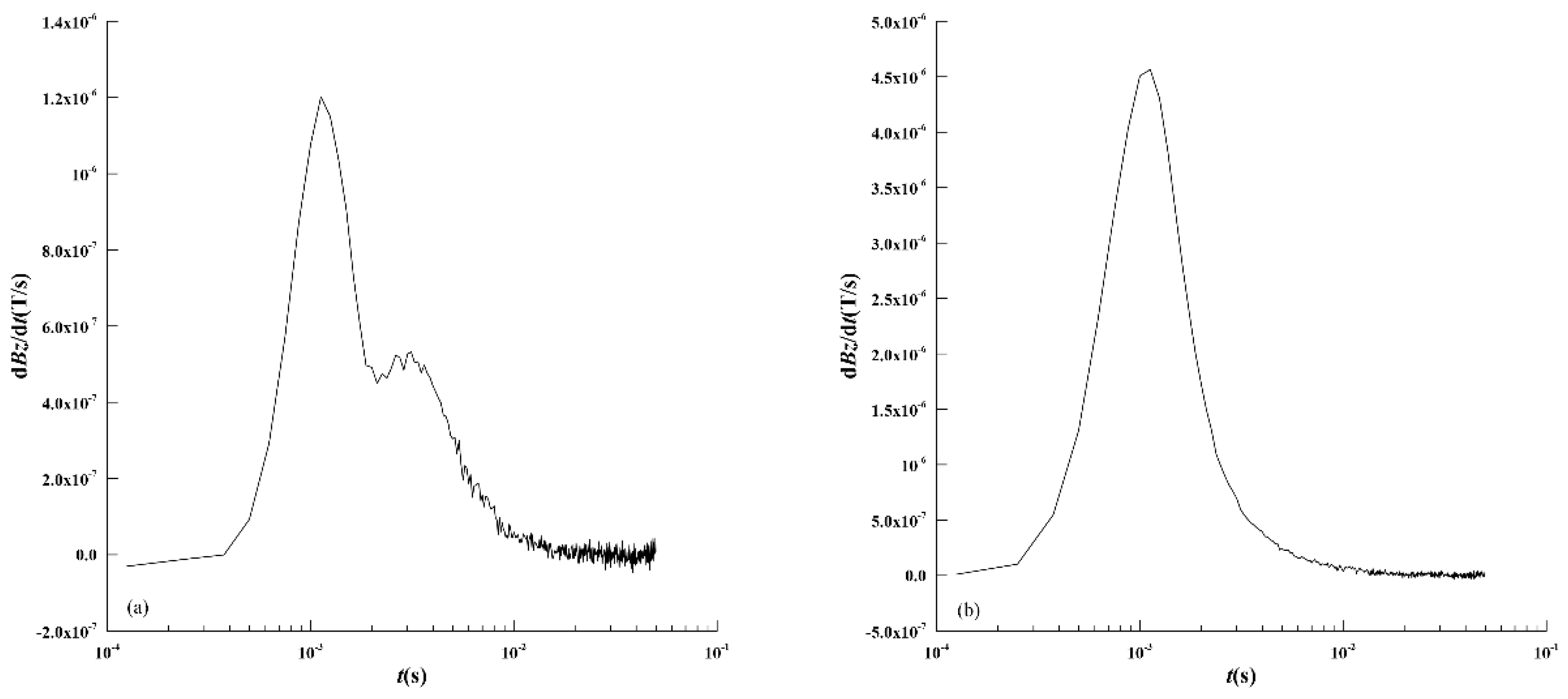


| Borehole Depth (m) | Mineral |
|---|---|
| 0–671.92 | Quartz monzodiorite porphyry |
| 671.92–686.32 | Chalcopyrite quartz monzodiorite porphyry |
| 686.32–727.16 | Quartz monzodiorite porphyry |
| 727.16–762.76 | Chalcolithic dolomitic marble |
| 762.76–777.96 | Copper–iron ore body |
| 777.96–1031.80 | Marble |
| 1031.80–1040.40 | Quartz monzodiorite porphyry |
| 1040.40–1049.00 | Copper–iron ore body |
| 1049.00–1107.20 | Quartz monzodiorite porphyry |
Disclaimer/Publisher’s Note: The statements, opinions and data contained in all publications are solely those of the individual author(s) and contributor(s) and not of MDPI and/or the editor(s). MDPI and/or the editor(s) disclaim responsibility for any injury to people or property resulting from any ideas, methods, instructions or products referred to in the content. |
© 2024 by the authors. Licensee MDPI, Basel, Switzerland. This article is an open access article distributed under the terms and conditions of the Creative Commons Attribution (CC BY) license (https://creativecommons.org/licenses/by/4.0/).
Share and Cite
Guo, Q.; Mao, Y.; Yan, L.; Chen, W.; Yang, J.; Xie, X.; Zhou, L.; Li, H. Key Technologies for Surface-Borehole Transient Electromagnetic Systems and Applications. Minerals 2024, 14, 793. https://doi.org/10.3390/min14080793
Guo Q, Mao Y, Yan L, Chen W, Yang J, Xie X, Zhou L, Li H. Key Technologies for Surface-Borehole Transient Electromagnetic Systems and Applications. Minerals. 2024; 14(8):793. https://doi.org/10.3390/min14080793
Chicago/Turabian StyleGuo, Qingming, Yurong Mao, Liangjun Yan, Wenhui Chen, Jupeng Yang, Xingbing Xie, Lei Zhou, and Haojin Li. 2024. "Key Technologies for Surface-Borehole Transient Electromagnetic Systems and Applications" Minerals 14, no. 8: 793. https://doi.org/10.3390/min14080793







